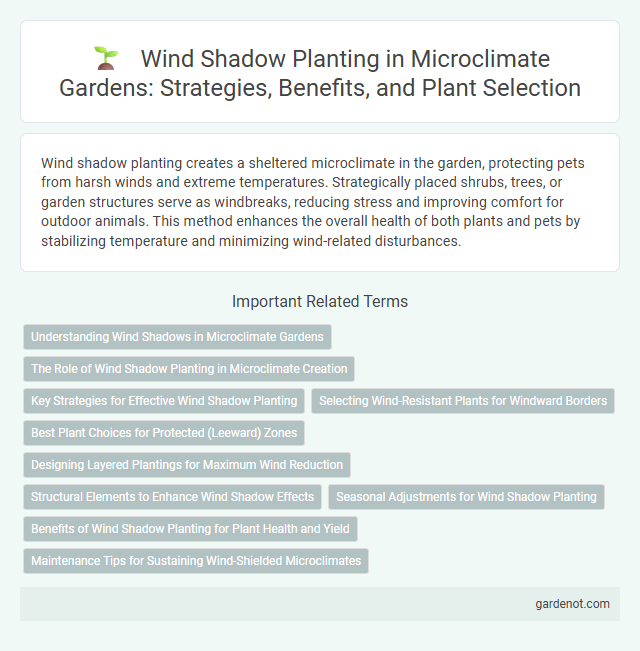Wind shadow planting creates a sheltered microclimate in the garden, protecting pets from harsh winds and extreme temperatures. Strategically placed shrubs, trees, or garden structures serve as windbreaks, reducing stress and improving comfort for outdoor animals. This method enhances the overall health of both plants and pets by stabilizing temperature and minimizing wind-related disturbances.
Understanding Wind Shadows in Microclimate Gardens
Wind shadow planting in microclimate gardens leverages natural barriers like trees, shrubs, or structures to reduce wind speed and protect delicate plants. Understanding wind shadows involves analyzing prevailing wind direction and intensity to strategically position vegetation that minimizes wind stress and conserves soil moisture. Proper wind shadow design enhances plant growth, reduces water evaporation, and creates a more stable microclimate within the garden.
The Role of Wind Shadow Planting in Microclimate Creation
Wind shadow planting plays a crucial role in creating a microclimate by strategically positioning vegetation to reduce wind speed and turbulence around a garden space. This reduction in wind exposure helps moderate temperature fluctuations, retains soil moisture, and protects delicate plants from physical damage. Effective wind shadow planting enhances garden resilience, promoting healthier plant growth and increased biodiversity within the microclimate.
Key Strategies for Effective Wind Shadow Planting
Wind shadow planting effectively reduces wind speed and protects sensitive plants by strategically positioning windbreaks such as dense shrubs or trees on the windward side. Selecting species with strong, flexible branches and deep root systems enhances durability and minimizes wind damage. Incorporating layered plantings at varying heights creates a microclimate that stabilizes temperature and humidity, promoting healthier growth within the garden.
Selecting Wind-Resistant Plants for Windward Borders
Selecting wind-resistant plants for windward borders enhances the microclimate by reducing wind speed and protecting delicate garden areas. Species such as Viburnum tinus, Juniperus communis, and Berberis thunbergii demonstrate high tolerance to strong winds and salt spray, ensuring durability in exposed locations. Incorporating these hardy shrubs stabilizes the soil, creates effective wind shadows, and improves overall garden resilience.
Best Plant Choices for Protected (Leeward) Zones
Best plant choices for wind shadow planting in protected leeward zones include species with delicate foliage and shallow root systems, such as ferns, hostas, and astilbes, which thrive in reduced wind stress. Hardy shrubs like boxwood and hydrangea offer structural resilience while benefiting from the calmer microclimate. Selecting plants adapted to lower wind exposure maximizes growth potential and garden vitality in sheltered areas.
Designing Layered Plantings for Maximum Wind Reduction
Designing layered plantings in a microclimate garden strategically reduces wind impact by combining tall trees, mid-height shrubs, and ground covers to create effective wind shadows. Each vegetation layer disrupts wind flow differently, with dense foliage absorbing and redirecting air currents, resulting in a calmer, more protected environment. Optimal spatial arrangement and species selection based on wind patterns enhance this natural barrier, improving plant health and garden microclimate stability.
Structural Elements to Enhance Wind Shadow Effects
Structural elements such as pergolas, trellises, and dense evergreen hedges significantly enhance wind shadow effects by reducing wind speed and creating sheltered microclimates in garden spaces. Strategic placement of these barriers according to prevailing wind directions optimizes protection for delicate plants and improves overall garden resilience. Incorporating varied heights and densities in planting layers further amplifies wind buffering, promoting healthier plant growth and microclimate stabilization.
Seasonal Adjustments for Wind Shadow Planting
Seasonal adjustments for wind shadow planting involve selecting plant species with varying growth habits and foliage density to provide effective shelter during different times of the year. In winter, evergreen shrubs with dense branches reduce wind impact and retain warmth, while deciduous plants offer enhanced airflow and light penetration in summer. Strategic layering and timing of plant growth support microclimate stability, promoting plant health and garden productivity through seasonal wind variations.
Benefits of Wind Shadow Planting for Plant Health and Yield
Wind shadow planting creates a sheltered microclimate that reduces wind stress on plants, minimizing physical damage and water loss through transpiration. By protecting crops from strong winds, this technique improves nutrient uptake and promotes healthier growth, resulting in increased plant resilience and higher yields. Enhanced microclimatic conditions also support beneficial soil microorganisms, further boosting plant health and productivity.
Maintenance Tips for Sustaining Wind-Shielded Microclimates
Regularly prune wind shadow plants to maintain dense foliage, enhancing their effectiveness as natural windbreaks. Mulch around the base to retain soil moisture and suppress weeds, supporting plant health in exposed microclimate zones. Inspect for pests and diseases frequently, ensuring the integrity of the wind-shielded environment is not compromised.
Wind shadow planting Infographic

 gardenot.com
gardenot.com